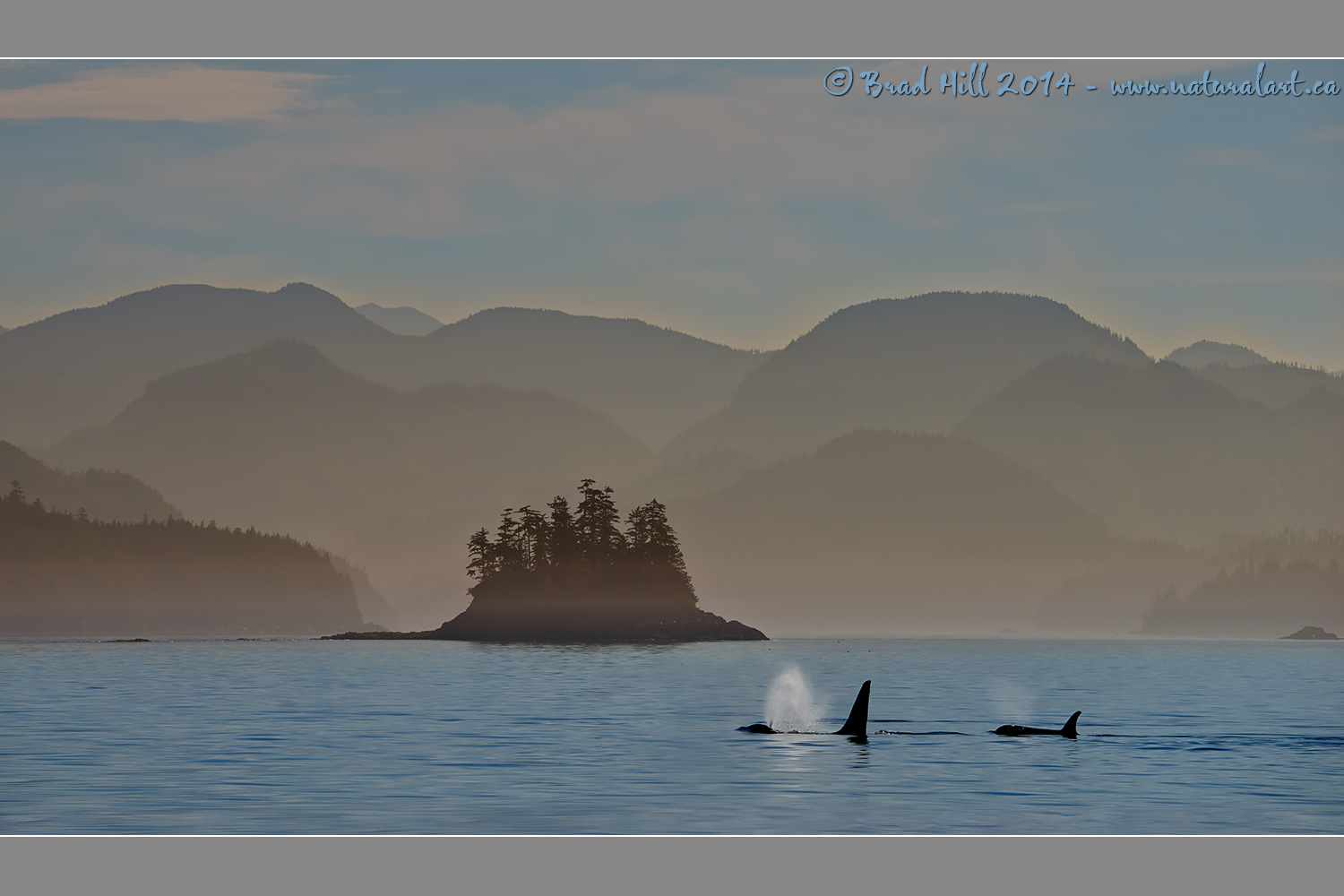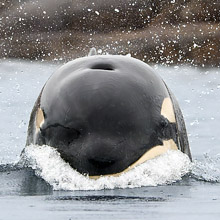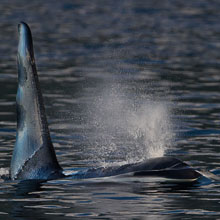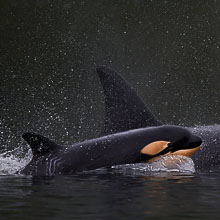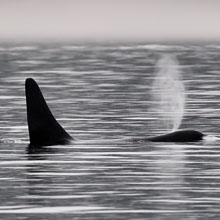Availability: Undetermined - Enquiries?
In the Field
Approaching Paradise. Northern Vancouver Island Region, BC, Canada. August 14, 2014.
While the timber industry may not be fond of forest fires, ecologists and photographers don't seem to mind them! Ecologists see forest fires as necessary parts of natural cycles and as regenerative. Photographers like 'em because the affect they can have on haze (and sunrises and sunsets!). Even without the warm tones added to the background by distant forest fires this was a "delicious" scene to observe - as I saw the bull killer whale and his companion (which is likely a female) swimming in front of this backdrop it was real hard not to smile! In a perfect world I would have preferred if the two orcas surfaced and blew a few metros further over on the right (so they didn't overlap the darkest and closest of the islets) but hey - whoever said we have a perfect world?
I've said many times that the D800 series of cameras aren't Nikon's best cameras for shooting wildlife (this image with a D800e), but given the right light, they are close to the best cameras you can find for shooting animalscapes (at least for now). With their amazing dynamic range (up to about ISO 500), their great autofocus system, and resolution galore...well...shooting landscape scenes with wildlife in them (which is pretty much the definition of an animalscape) is a real treat!
Here's a higher resolution (2400 pixel) version for your perusal:
• Approaching Paradise: Download 2400 pixel image (JPEG: 701 KB)
ADDITIONAL NOTES:
1. This image - in all resolutions - is protected by copyright. I'm fine with personal uses of it (including use as desktop backgrounds or screensavers on your own computer), but unauthorized commercial use of the image is prohibited by law. Thanks in advance for respecting my copyright!
2. Like all wildlife photographs on this website, this image was captured following the strict ethical guidelines described in The Wildlife FIRST! Principles of Photographer Conduct. I encourage all wildlife photographers to always put the welfare of their subjects above the value of their photographs.
3. This image was captured during my "Humpback, Orcas, Sea Lions & More" photo tour in August of 2014. Each year I offer trips into two different parts of the Great Bear Rainforest as well as one to photograph aquatic mammals and oceanscapes near the northern tip of Vancouver Island. And, in selected years, I also offer photo tours to locations to capture other highly sought-after subjects, such as various owl species of the boreal forest and wildlife of Canada's Arctic. Details about these trips can be found on the Photo Tours page of this website.
Behind the Camera
Approaching Paradise. Northern Vancouver Island Region, BC, Canada. August 14, 2014.
Digital Capture; Compressed RAW (NEF) 14-bit format; ISO 160.
Nikon 800e paired with Nikkor AF-S 80-400mm f4.5-5.6 VR - hand-held from sailboat. VR on in Normal mode.
1/800s @ f11; -0.33 stop compensation from "recommended" matrix-metered exposure setting.
At the Computer
Approaching Paradise. Northern Vancouver Island Region, BC, Canada. August 14, 2014.
RAW Conversion to 16-bit TIFF, including first-pass/capture sharpening using Phase One's Capture One Pro 7.
Further digital corrections on resulting 16-bit TIFF file using Adobe's Photoshop CC 2014. Photoshop adjustments included minor exposure and contrast tweaks, and selective sharpening for web output. Note that there are no adjustments to image saturation on this shot.
Conservation
Approaching Paradise. Northern Vancouver Island Region, BC, Canada. August 14, 2014.
Ten percent of the revenue generated by this image will be donated to Raincoast.
Species Status in Canada*: Endangered - Northeast Pacific southern resident population; Threatened - Northeast Pacific transient population and the Northeast Pacific northern resident population; Special Concern - Northeast Pacific offshore population.
Killer Whales (Orcinus orca) have an extremely high profile in modern pop culture and have become the "poster child" of a number of conservation groups. In most areas where Killer Whales are found they show a remarkable ability to adapt to a variety of habitats - they are found in all oceans, in water ranging in temperature from below 0 Celsius to almost hot tropical waters, and will occasionally even spend significant amounts of time in brackish water or even rivers.
Because the population sizes of Killer Whales are very low and because they have a very low reproductive rate, they face immediate risk from human-related environmental disturbances, including the immunotoxic effects of toxic chemicals we pour into the oceans and to reduction in prey availability (such as salmon).
These two Killer Whales were photographed along the coast in British Columbia's Great Bear Rainforest. The Raincoast Conservation Society is fighting to protect the Great Bear Rainforest along the central and northern coast of British Columbia. This unique ecosystem harbours a strong population of many high-profile species such as Brown Bears and Gray wolves, plus many species that serve as prey for the Killer Whale. If you are looking for a meaningful way to contribute to the conservation of the Great Bear Rainforest and all its associated species, Raincoast will provide maximal "bang" for your conservation dollars.
For more information on the status of Killer Whales in Canada, go to: http://www.speciesatrisk.gc.ca and search under "Killer Whale".
*as determined by COSEWIC: The Committee on the Status of Endangered Wildlife in Canada












